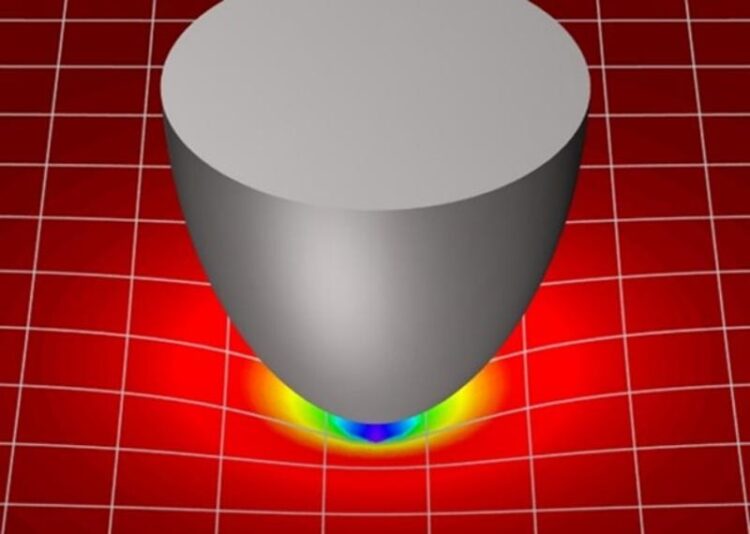Guidelines to exploring nanoscale flexoelectricity via AFM tip pressing

Research on AFM tip pressing-driven nanoscale flexoelectricity
Credit: POSTECH
When non-uniform force is applied to a material, it exhibits spontaneous electrical polarization induced by a strain gradient. This phenomenon is called flexoelectricity. There is no need to apply an electric field when utilizing this property and therefore, it shows promising device applications in smartphones, generators, and actuators. Recently, a Korean research team has developed a method to control the flexoelectricity of nanometer-sized (one-billionth of a meter) materials by pressing with the AFM tip.
A joint team of researchers led by Professor Daesu Lee (Department of Physics at POSTECH), Professor Tae Won Noh and Dr. Sung Min Park (Department of Physics and Astronomy at Seoul National University), and Professor Sang Mo Yang (Department of Physics at Sogang University) has succeeded in producing flexoelectricity in solids using the atomic force microscopy (AFM) and published a comprehensive guideline that outlines the process for the first time.
Many components in a smartphone use piezoelectricity to create an electric field. Piezoelectricity is the property of generating an electric field when uniform force is applied to a material in one direction, unlike flexoelectricity. However, since lead zirconate titanate (PZT) – which exhibits high piezoelectricity – contains elements that are harmful to the human body, developing an alternative material is imperative.
Flexoelectricity, which can be used as an alternative, was found to be too small in bulk solids to be practical for industrial use. However, it has been discovered within the past decade that as a material reduced to nanoscale dimensions, its flexoelectricity increased. This has brought on great interest in its technological potential and applications.
One of the most powerful ways to harness nanoscale flexoelectricity is to press the surface of a material with an AFM tip. However, a comprehensive guideline has not been compiled on this process until now. The complex microscopic effects that appear during the pressing have not been identified either.
To this, Professor Daesu Lee’s joint research team came up with a method to control flexoelectricity using the AFM. At the same time, the researchers broadly presented other microscopic phenomena that can appear in addition to flexoelectricity and a methodology for distinguishing flexoelectricity from other phenomena.
Nanoscale materials exhibiting flexoelectricity can not only replace conventional piezoelectric materials, but also be used as generators and actuators in nanoscale units. They show potential to be applicable as a semiconductor or a catalyst device or as a photovoltaic cell, in which current flows when light is irradiated.
“The atomic force microscopy technology has become an important foundation for many studies on the flexoelectricity of nanoscale materials over the past 10 years,” explained Professor Daesu Lee of POSTECH. He noted, “We anticipate that the findings from this study will help continue the rapid advancement of related research areas in the future.”
Published in the international academic journal Applied Physics Reviews, this study was supported by the Young Researcher Program and the Regional Leading Research Center Program of the National Research Foundation, and by the Institute for Basic Science of Korea.
Journal: Applied Physics Reviews
DOI: 10.1063/5.0067429
Article Title: Flexoelectric control of physical properties by atomic force microscopy
Article Publication Date: 29-Dec-2021
Media Contact
Jinyoung Huh
Pohang University of Science & Technology (POSTECH)
jyhuh@postech.ac.kr
Office: 82-54-279-2415
All latest news from the category: Physics and Astronomy
This area deals with the fundamental laws and building blocks of nature and how they interact, the properties and the behavior of matter, and research into space and time and their structures.
innovations-report provides in-depth reports and articles on subjects such as astrophysics, laser technologies, nuclear, quantum, particle and solid-state physics, nanotechnologies, planetary research and findings (Mars, Venus) and developments related to the Hubble Telescope.
Newest articles

Innovative 3D printed scaffolds offer new hope for bone healing
Researchers at the Institute for Bioengineering of Catalonia have developed novel 3D printed PLA-CaP scaffolds that promote blood vessel formation, ensuring better healing and regeneration of bone tissue. Bone is…

The surprising role of gut infection in Alzheimer’s disease
ASU- and Banner Alzheimer’s Institute-led study implicates link between a common virus and the disease, which travels from the gut to the brain and may be a target for antiviral…

Molecular gardening: New enzymes discovered for protein modification pruning
How deubiquitinases USP53 and USP54 cleave long polyubiquitin chains and how the former is linked to liver disease in children. Deubiquitinases (DUBs) are enzymes used by cells to trim protein…


